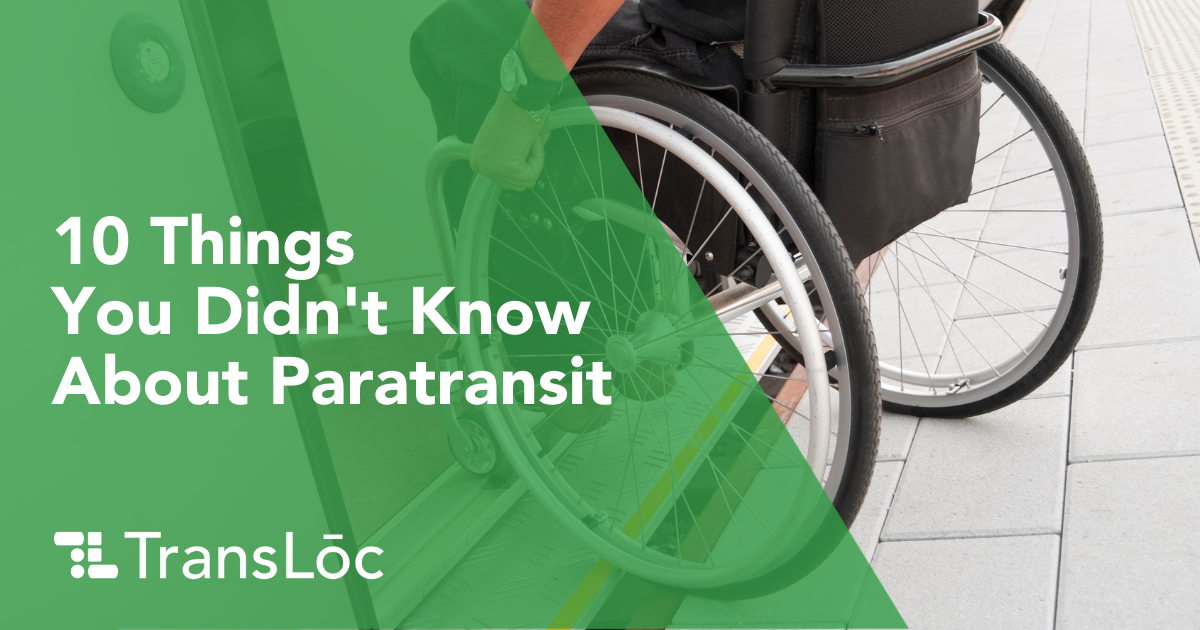
If you’re not familiar with paratransit, you should be.
As a special transportation service for people with disabilities, paratransit is often provided as a supplement to fixed-route bus and rail systems by public transit agencies. These agencies’ paratransit services come in a variety of forms, and vary widely in their degree of flexibility.
Without paratransit, however, countless Americans would be left without mobility options and thus stranded.
Let’s take a deeper look at how paratransit operates, how it affects the mobility of our country as a whole, and why it is so imperative we make it a viable option. Here are ten facts about paratransit that you might not know:
1) Two thirds of transit agencies provide paratransit services.
Of the 6,804 transit agencies providing public transportation in 2013, 4,583 were non-profit organizations operating demand-response (paratransit) services, primarily for persons with disabilities and senior citizens. (APTA)
2) A lot more people use paratransit than you think.
More than 223 million unlinked passenger trips using paratransit services are recorded each year, serving tens of millions of riders in the United States alone.
3) More vehicles are used for paratransit than any other public transit.
68,559 vehicles were available for typical peak paratransit services in 2013, forming the largest fleet of vehicles in all public transportation modes. (APTA)
4) Contractors account for the vast majority of paratransit operators.
Nearly 75% of paratransit service is provided by contractors. About 80% of the vehicles operated by contractors are owned by the transit agencies. (APTA)
5) Paratransit expenditure is a small portion of total transit budgets.
The total expenditure on paratransit in 2013 was $5.75 billion, 9.5% of the total expenditure on public transportation. (APTA)
6) Paratransit riders use the service an average of three times per month.
The average number of registered users of ADA paratransit services was 5,831 per transit agency in 2010, while the average number of ADA paratransit trips provided by a transit agency were 184,856—approximately 32 trips per user, per agency. (GAO)
7) A paratransit trip costs three times as much as a fixed route for the agency to operate.
In 2010, the average fare per trip for ADA paratransit was $2.09 and the average cost to the transit agency per trip was $29.30. The average fare collected for a fixed-route trip was $1.13 and average cost was $8.15, in 2010. Transit agencies cannot base ADA paratransit fares on paratransit costs; fares may not exceed twice the fare that would be charged to an individual paying full fare for a trip of similar length, at a similar time of day on the fixed route. (GAO)
8) Paratransit applications have to reviewed within 21 days of submission.
If the transit agency has not made a determination of ADA paratransit eligibility by a date 21 days after the submission of an individual’s completed eligibility application, the applicant must be treated as eligible and provided service unless and until the transit agency denies the application. (FTA)
9) Over half of paratransit agencies coordinate with other providers.
As of 2012, about 59% of transit agencies are coordinating with health and human services providers in order to improve ADA paratransit services or address the costs of providing service. Also, about 44% of transit agencies are coordinating with other local transit agencies to improve connectivity, including 6 of the 10 largest transit agencies. (GAO)
10) Technology is improving paratransit service across for millions of riders.
In 2014, nearly 40% of providers reported adding new technology to their operation.Of the technologies being implemented, scheduling and dispatch software took the top spot, with 53%, while AVL systems and IVR/call systems where the next highest, with 30% and 27% respectively. Camera systems, mobile data terminals and CNG vehicles comprised some of the “other” category reported by 43%. (Metro Magazine)
As you can see, paratransit is a vital part of public transportation for thousands of dependent users across the US. As technology advances, agencies will have options to improve their service while increasing efficiency and decreasing costs. At TransLoc, we want help agencies, dispatchers, and riders solve transit-related problems using technology.
Contact us today to learn more about our Paratransit options through TransLoc OnDemand!